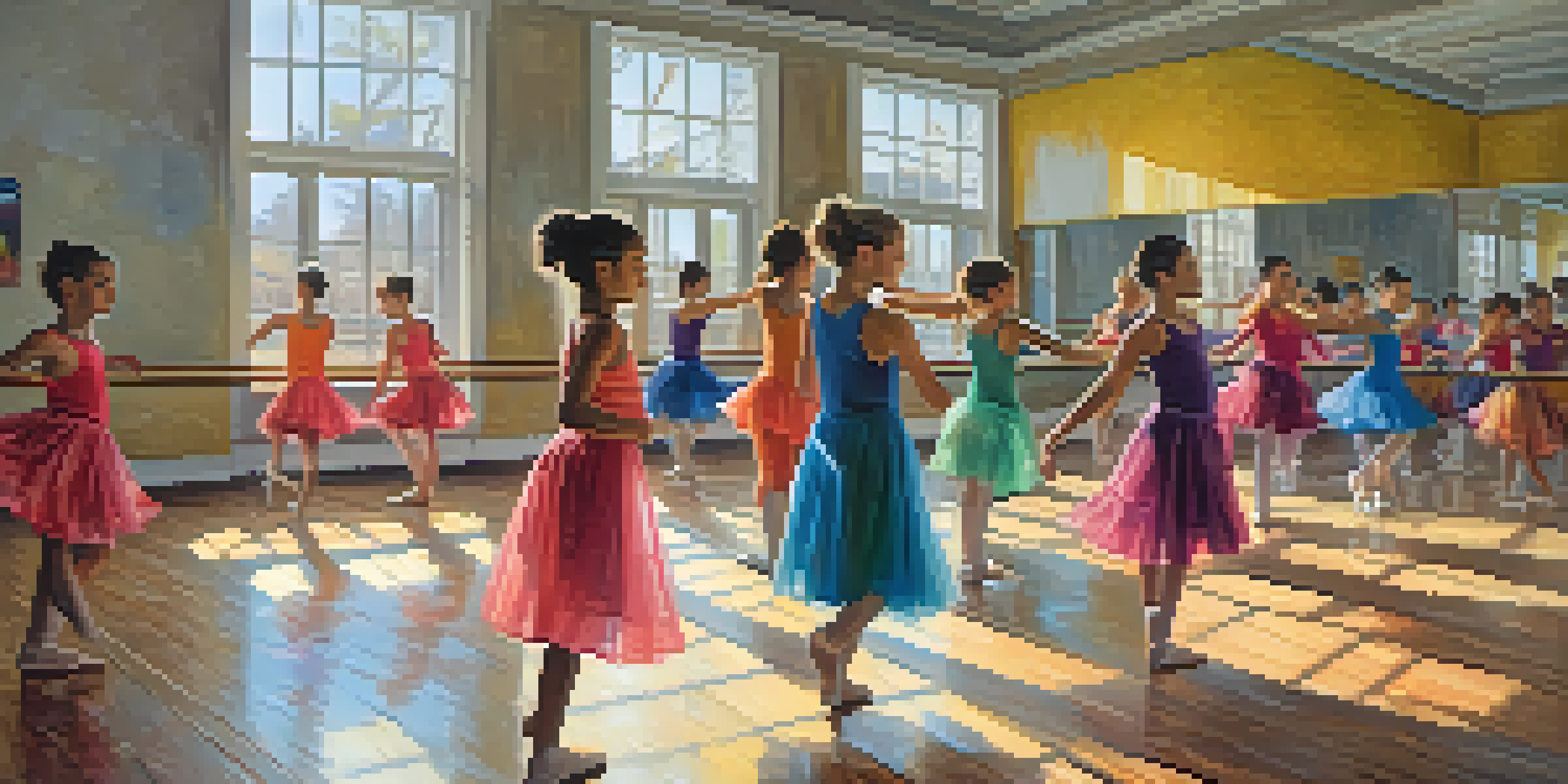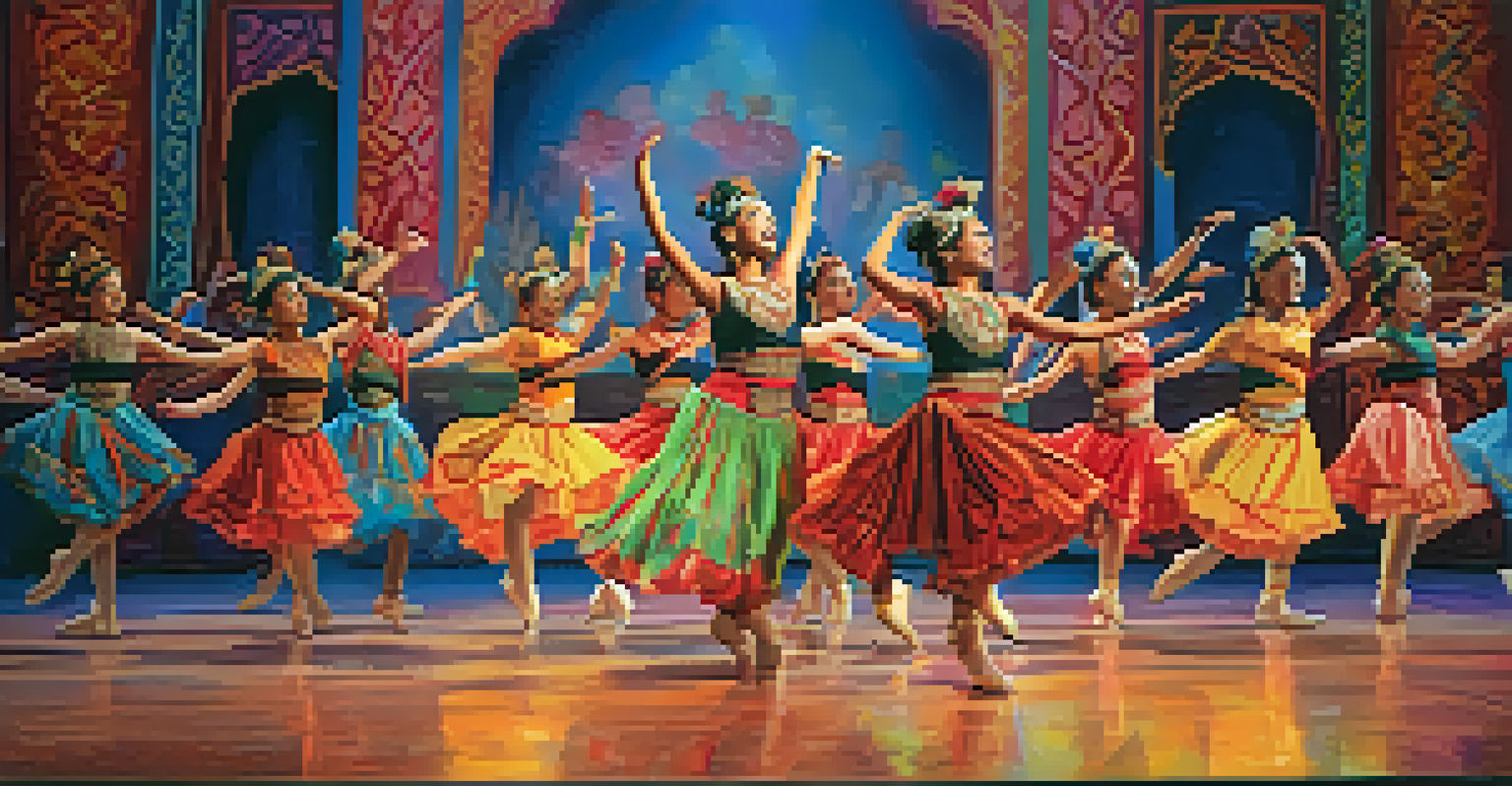Skill Development Through Dance: A Youth Perspective

The Power of Dance in Skill Development
Dance is more than just movement; it's a powerful tool for learning. It engages youth physically, mentally, and emotionally, helping them develop a variety of skills. From coordination to creativity, dance provides a unique way for young people to express themselves and learn new abilities.
Dance is the hidden language of the soul.
When youth participate in dance, they not only improve their physical fitness but also enhance their cognitive functions. This dual benefit fosters a holistic approach to skill development. For example, learning choreography involves memorization and pattern recognition, which can translate to improved academic performance.
Additionally, dance encourages teamwork and communication. Whether in a group routine or a partner dance, young dancers learn the importance of collaboration and listening to others, skills that are invaluable in all areas of life.
Building Confidence Through Movement
One of the most significant benefits of dance for youth is the boost in self-confidence. As they learn new techniques and perform in front of others, dancers often discover a newfound belief in their abilities. This confidence can extend beyond the dance floor into other areas of their lives.

Consider a shy teenager who struggles with public speaking. By participating in dance performances, they gradually become more comfortable in front of an audience. This experience can help them tackle other challenges, like giving a presentation in school, with greater ease.
Dance Boosts Confidence and Growth
Participating in dance helps youth build self-confidence and encourages personal growth through performance experiences.
Moreover, the supportive environment often found in dance classes encourages youth to take risks and step outside their comfort zones. This nurturing space fosters personal growth, allowing them to embrace their individuality and unique talents.
Cultivating Discipline and Work Ethic
Dance requires dedication and practice, instilling a strong work ethic in young dancers. The commitment to mastering a routine or perfecting a technique teaches them the value of perseverance. This lesson can be applied to their academic pursuits and future careers.
The dance is a poem of which each movement is a word.
For instance, a young dancer might spend weeks rehearsing for a performance, learning the importance of setting goals and working diligently to achieve them. This discipline becomes a fundamental part of their character, shaping how they approach challenges.
Additionally, regular practice helps youth develop time management skills. Balancing dance with school and other responsibilities teaches them how to prioritize tasks, a skill that will serve them well throughout their lives.
Enhancing Social Skills Through Group Dance
Dance provides a fantastic platform for youth to build social skills. Whether in a group class or a dance team, they interact with peers, fostering friendships and connections. This social aspect is vital for young people's emotional well-being and personal development.
In group dance settings, youth learn to cooperate and collaborate with others. They develop empathy by understanding different perspectives and working towards a common goal. This experience can help improve their interpersonal relationships, both in and outside of dance.
Dance Enhances Social Skills
Group dance activities foster social interactions, cooperation, and improve communication skills among young participants.
Moreover, participating in dance can also enhance communication skills. Dancers must express themselves not only through movement but also through verbal cues and feedback, helping them articulate their thoughts and feelings more effectively.
Expressing Emotions and Building Resilience
Dance serves as an emotional outlet for youth, allowing them to express feelings that may be difficult to articulate. Through movement, they can process their emotions and communicate their experiences creatively. This form of self-expression is essential for mental health and emotional resilience.
For many young dancers, routine challenges like a difficult performance or competition can also teach them resilience. Learning to cope with setbacks, such as not achieving the desired outcome, prepares them for life's ups and downs.
Moreover, dance encourages a sense of community and support. Sharing experiences with fellow dancers creates bonds that can help youth navigate their emotional landscapes more effectively.
Fostering Creativity and Problem-Solving Skills
Dance is inherently creative, allowing youth to explore their artistic sides. By experimenting with movement and choreography, they learn to think outside the box, fostering innovative problem-solving skills. This creativity can be a valuable asset in all aspects of life.
For example, when choreographing a dance piece, a young dancer must consider various elements, such as music, style, and expression. This process encourages critical thinking and adaptability, skills that are essential in today's fast-paced world.
Dance Cultivates Creativity and Discipline
Through dance, youth develop creativity and a strong work ethic, learning the value of dedication and problem-solving.
Additionally, creativity in dance can lead to other artistic pursuits. Many dancers find themselves inspired to explore music, acting, or visual arts, broadening their horizons and enriching their creative journeys.
The Role of Dance in Cultural Awareness
Dance is a rich reflection of culture, and participating in it can foster a greater understanding of diverse backgrounds. For youth, this exposure helps build cultural awareness and appreciation. Learning different dance styles can spark interest in various traditions and histories.
For instance, a student who learns Bollywood dance may develop an interest in Indian culture, leading them to explore its music, cuisine, and language. This connection fosters inclusivity and respect for diversity.

Furthermore, dance can serve as a bridge between different communities. Collaborative performances that bring together dancers from various backgrounds promote unity and understanding, reinforcing the importance of cultural exchange.
Conclusion: The Lasting Impact of Dance on Youth
In conclusion, the benefits of dance extend far beyond the joy of movement. It plays a pivotal role in skill development, confidence building, and emotional expression for youth. The lessons learned in dance can positively influence their personal and academic lives, shaping them into well-rounded individuals.
As young people engage in dance, they gain valuable life skills that will serve them throughout their journeys. From discipline and resilience to creativity and cultural awareness, the impact of dance is profound and lasting.
Encouraging youth to participate in dance can open doors to personal growth and development. The journey through dance is not just about mastering steps; it's about discovering oneself and embracing the beauty of movement.